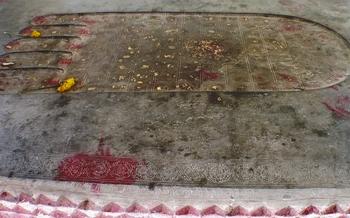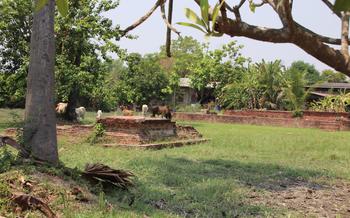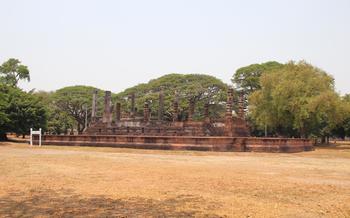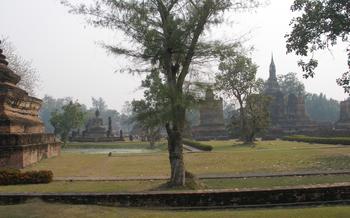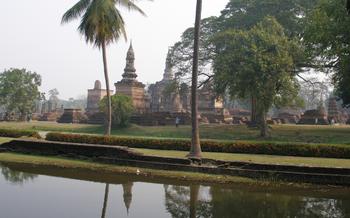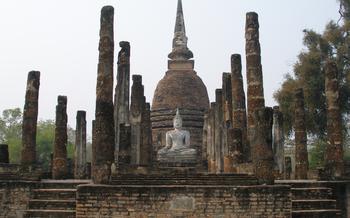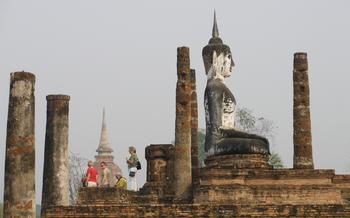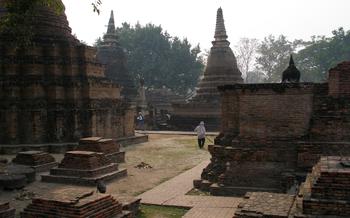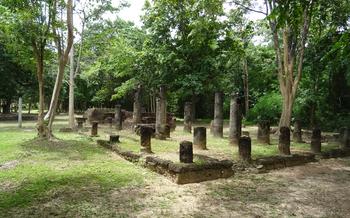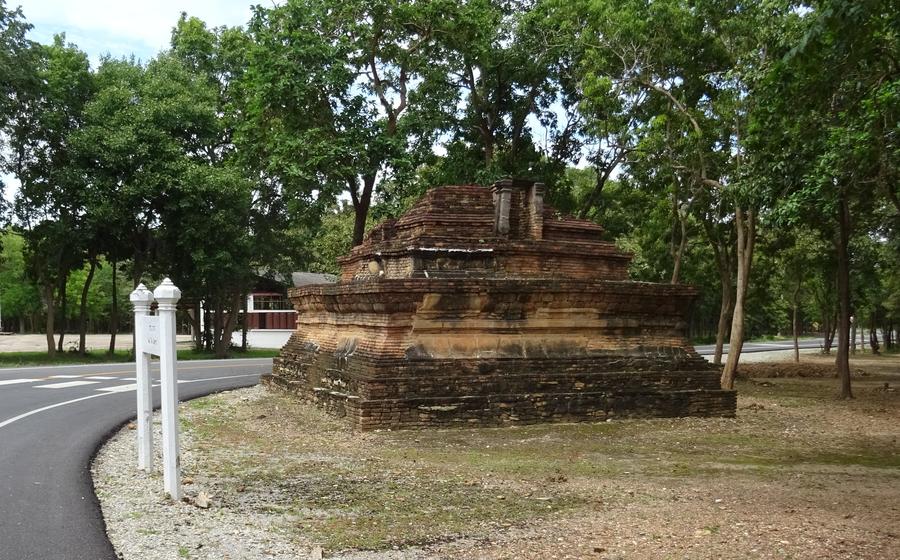
Wat Pa Daeng
- Architectural Features
- Stupa and Buddha Statues
- Ordination Hall and Murals
- Viharn and Buddha Footprint
- Surrounding Grounds and Landscape
- Cultural Significance
- UNESCO World Heritage Site
- Visitor Information
- Photography Tips
- Local Cuisine and Restaurants
- Transportation and Getting There
- Accommodation and Where to Stay
- Tours and Guided Visits
Architectural Features
Wat Pa Daeng stands apart for its exceptional architectural style, a harmonious blend of Sukhothai and Sri Lankan influences. The temple's most striking feature is its impressive stupa, rising majestically above the surrounding structures. Its bell-shaped dome, adorned with intricate moldings and crowned by a graceful pinnacle, exudes an aura of serenity and grandeur.
The ordination hall, known as the ubosot, is another architectural highlight of Wat Pa Daeng. Supported by massive pillars, the hall's interior is adorned with exquisite murals depicting scenes from the Buddha's life and teachings. The viharas, or assembly halls, also showcase beautiful architectural details, with their elegant roofs and intricate carvings.
The temple's layout and design reflect the principles of Buddhist cosmology. The stupa, representing Mount Meru, the center of the universe, occupies the central position. The ordination hall and viharas are arranged symmetrically around the stupa, symbolizing the four cardinal directions.
The materials used in the construction of Wat Pa Daeng are predominantly brick and stucco. The bricks, meticulously laid and adorned with intricate patterns, create a visually appealing texture. The stucco, a mixture of lime and sand, provides a smooth and durable surface for the murals and other decorative elements.
Stupa and Buddha Statues
At the heart of Wat Pa Daeng stands its magnificent stupa, a towering structure that dominates the temple's skyline. The stupa, also known as a chedi, is a symbol of Buddhist enlightenment and represents the Buddha's journey to nirvana. Its graceful bell-shaped form tapers towards the sky, symbolizing the path of liberation from earthly desires. The stupa is adorned with intricate stucco decorations and features a series of niches housing Buddha images, each with a unique posture and expression.
The interior of the stupa enshrines a collection of Buddha statues, each radiating a sense of serenity and spiritual presence. These Buddha images are crafted from various materials, including bronze, stone, and stucco, and exhibit distinct styles and iconography. Some Buddhas are depicted in the classic seated meditation pose, their hands resting in the lap, while others stand tall, exuding an aura of strength and compassion. The diversity of these Buddha statues reflects the rich artistic heritage of Sukhothai and the temple's enduring role as a center of Buddhist devotion.
Ordination Hall and Murals
The ordination hall of Wat Pa Daeng is a masterpiece of religious architecture and artistry. This sacred space is where young men are ordained as Buddhist monks in a solemn and traditional ceremony. The hall's design is both elegant and functional, featuring a gabled roof supported by massive wooden pillars. The interior of the ordination hall is adorned with exquisite murals that depict scenes from the life of Buddha and the history of Buddhism. These murals are not only aesthetically pleasing but also serve as a source of inspiration and teachings for the monks and visitors alike.
The walls of the ordination hall are covered in vibrant and intricate murals that narrate the stories of Buddha's life, from his birth and enlightenment to his teachings and ultimate Nirvana. One of the most striking murals portrays the moment when Buddha attained enlightenment under the bodhi tree, surrounded by a multitude of celestial beings. Another mural depicts Buddha's first sermon in the Deer Park, where he expounded on the Four Noble Truths and the Eightfold Path. These murals serve as visual aids for monks and devotees, reminding them of the teachings and principles of Buddhism.
Viharn and Buddha Footprint
The viharas, or assembly halls, at Wat Pa Daeng are equally impressive. These structures serve as gathering places for monks and devotees to engage in religious ceremonies, teachings, and meditation. The viharas feature intricate carvings and decorations that showcase the artistry and craftsmanship of the temple's builders.
One of the viharas houses a Buddha footprint, a sacred relic that holds immense significance in Buddhist tradition. According to legend, the footprint was left by the Buddha himself during his visit to Thailand. Devotees flock to the vihara to pay homage to the footprint, which is believed to possess miraculous powers and bring blessings to those who venerate it. The footprint is adorned with gold leaf and surrounded by offerings of flowers and incense, creating a serene and spiritual atmosphere.
Surrounding Grounds and Landscape
The surrounding grounds of Wat Pa Daeng exude an aura of serenity and tranquility, inviting visitors to immerse themselves in the temple's peaceful ambiance. The temple's location, nestled amidst lush greenery and tranquil waterways, amplifies its spiritual significance. The natural beauty of the surrounding landscape complements the temple's grandeur, creating a harmonious blend of nature and spirituality.
Wat Pa Daeng's serene setting allows visitors to escape the hustle and bustle of city life and connect with the tranquility of their surroundings. The temple's grounds are meticulously maintained, featuring well-manicured gardens, vibrant flowerbeds, and towering trees that provide shade and a sense of seclusion. The temple's location on the banks of the Yom River adds to its charm, offering visitors a chance to enjoy picturesque views of the river and the surrounding countryside.
Beyond the temple's immediate vicinity, the landscape surrounding Wat Pa Daeng is equally captivating. Visitors can explore the nearby rice fields, orchards, and forests, each offering its own unique charm and beauty. The temple's location within the Sukhothai Historical Park provides easy access to other significant temples, ancient ruins, and historical sites, allowing visitors to delve deeper into the region's rich cultural heritage.
Wat Pa Daeng's natural surroundings play a vital role in the temple's ecosystem. The temple's lush gardens provide a habitat for various bird species, while the river and its surrounding vegetation support a diverse array of aquatic life. The temple's serene environment attracts a variety of wildlife, including squirrels, lizards, and butterflies, adding to the temple's biodiversity and contributing to the overall beauty and tranquility of the site.
Cultural Significance
Wat Pa Daeng holds immense cultural significance as a religious and spiritual center in Sukhothai. Throughout history, it has been a place of worship, meditation, and spiritual enlightenment for both monks and laypeople. Devotees from far and wide flock to the temple to pay homage to the Buddha, seek blessings, and find solace in the serene ambiance.
Wat Pa Daeng serves as a vital part of the local community, fostering a sense of unity and belonging among the residents. It is a place where people gather for religious ceremonies, festivals, and community events. The temple actively participates in various social initiatives, such as supporting education, healthcare, and cultural preservation, strengthening its role as a pillar of the community.
The cultural significance of Wat Pa Daeng extends beyond its religious and communal functions. It is a treasure trove of Thai art and architecture. The exquisite murals adorning the walls of the ordination hall depict scenes from the life of the Buddha and Jataka tales, providing a glimpse into the rich cultural heritage of Thailand. The temple's well-preserved architecture showcases the ingenuity and craftsmanship of ancient Thai artisans, serving as a reminder of the kingdom's glorious past.
UNESCO World Heritage Site
Wat Pa Daeng's exceptional historical and cultural value has been recognized by the United Nations Educational, Scientific and Cultural Organization (UNESCO). In 1991, the temple was inscribed on the prestigious UNESCO World Heritage List, becoming one of the first sites in Thailand to receive this prestigious designation.
The temple's inclusion on the World Heritage List highlights its outstanding universal value and its significance as a cultural landmark. UNESCO recognized Wat Pa Daeng for meeting several criteria, including its exceptional representation of the Sukhothai architectural style, its well-preserved state, and its unique collection of Buddha images and murals.
As a World Heritage Site, Wat Pa Daeng is afforded special protection and recognition. UNESCO's designation ensures that the temple will be preserved and maintained for future generations, allowing visitors from around the world to appreciate its beauty and historical significance.
Visitor Information
Planning a visit to Wat Pa Daeng is a rewarding experience for travelers seeking cultural immersion and historical exploration. Here's some practical information to ensure a smooth and enjoyable visit:
-
Opening Hours: Wat Pa Daeng is open to visitors daily from 8:00 AM to 5:00 PM. The temple is closed on public holidays, so it's advisable to check before planning your visit.
-
Admission Fees: The entrance fee for Wat Pa Daeng is 50 baht for foreign visitors and 20 baht for Thai citizens. This fee helps maintain the temple's upkeep and preservation efforts.
-
Dress Code: As a sacred religious site, visitors are expected to dress respectfully. Avoid wearing shorts, tank tops, or revealing clothing. It's advisable to cover your shoulders and knees when visiting the temple.
-
Best Time to Visit: The best time to visit Wat Pa Daeng is during the early morning or late afternoon when the sun is not as intense. The temple is less crowded at these times, allowing you to fully appreciate its serene atmosphere and take stunning photographs without harsh shadows.
-
Nearby Attractions: After exploring Wat Pa Daeng, consider visiting other nearby attractions. The Sukhothai Historical Park, a UNESCO World Heritage Site, is just a short distance away and offers a glimpse into the ancient capital of the Sukhothai Kingdom. The Ramkhamhaeng National Museum, located within the park, houses a collection of artifacts and exhibits showcasing the region's rich history.
Photography Tips
Capture the Majestic Stupa: The iconic stupa of Wat Pa Daeng is a photographer's dream. Position yourself at a low angle to emphasize its grandeur against the clear blue sky. Experiment with different focal lengths to achieve a dramatic perspective.
Explore the Temple Grounds: Wander through the temple grounds, capturing the serene atmosphere and intricate details. Look for interesting angles and compositions, such as the interplay of light and shadow on the temple walls or the reflection of the stupas in the surrounding water.
Seek the Golden Hour: The warm glow of the golden hour, just before sunset, creates a magical ambiance at Wat Pa Daeng. This is the perfect time to capture the temple bathed in a soft, golden light, casting long shadows and enhancing the overall beauty of the scene.
Experiment with Black and White: The ancient and timeless nature of Wat Pa Daeng lends itself well to black-and-white photography. Convert your images to grayscale to create a sense of nostalgia and emphasize the temple's architectural details.
Use a Tripod for Stability: To capture sharp and clear images, especially in low-light conditions, consider using a tripod. This will help stabilize your camera, reducing camera shake and ensuring crisp shots.
Local Cuisine and Restaurants
Indulge in the flavors of traditional Thai cuisine near Wat Pa Daeng. Sample the local specialties, such as the spicy and sour papaya salad, the aromatic green curry, and the flavorful pad thai. For a truly authentic experience, head to the nearby street food stalls and markets. Try the grilled meats, fresh seafood, and delicious noodle dishes. Don't miss the chance to taste the famous mango sticky rice, a sweet and sticky dessert that perfectly complements the savory dishes. Whether you prefer a sit-down restaurant or a casual street food experience, you'll find plenty of options to satisfy your taste buds near Wat Pa Daeng.
Transportation and Getting There
Reaching Wat Pa Daeng from Sukhothai city is a breeze, with various transportation options at your disposal. Buses, a reliable and economical choice, depart regularly from the Sukhothai Bus Terminal, ensuring a comfortable journey to the temple. Alternatively, taxis offer a convenient and direct mode of transport, allowing you to set your own pace and explore the city's other attractions en route. For a more adventurous experience, hop on a tuk-tuk, a quintessential Thai vehicle, and enjoy a thrilling ride through the bustling streets. The approximate travel time from Sukhothai city to Wat Pa Daeng is around 30 minutes, and costs vary depending on the chosen mode of transport. If you prefer the freedom of self-driving, rental cars are readily available in Sukhothai, providing the flexibility to explore the city and its surroundings at your own leisure.
Accommodation and Where to Stay
When planning your visit to Wat Pa Daeng, you'll want to consider your accommodation options. Sukhothai offers a range of accommodation to suit all budgets and preferences.
For those seeking a luxurious and convenient stay, several upscale resorts and hotels are located within easy reach of the temple. These establishments offer amenities such as swimming pools, spas, and fine dining restaurants.
For a more budget-friendly option, numerous guesthouses and homestays are available in the vicinity of the temple. These accommodations provide a comfortable and authentic Thai experience, often with shared facilities and communal areas.
To find the best deals and discounts, it's advisable to book your accommodation in advance, especially during peak tourist season. Online booking platforms and travel agents can help you compare prices and amenities to find the perfect place to stay.
Tours and Guided Visits
Exploring Wat Pa Daeng with a knowledgeable guide can greatly enhance your experience. Guided tours are available in various languages and provide in-depth insights into the temple's history, architecture, and religious significance. These tours typically cover all the major highlights of the temple, including the stupa, ordination hall, viharas, and Buddha statues.
The duration of guided tours varies, but most last around two to three hours. Some tours also include visits to other nearby temples or historical sites, offering a comprehensive overview of Sukhothai's rich cultural heritage.
To book a guided tour, you can either contact a local tour operator or inquire at your hotel or guesthouse. Advance reservations are recommended, especially during peak tourist season, to secure your spot.
By opting for a guided tour, you'll gain a deeper understanding of Wat Pa Daeng's significance and appreciate its intricate details that you might otherwise miss. Whether you're a history buff, an architecture enthusiast, or simply seeking a spiritual experience, a guided tour is an excellent way to make the most of your visit to this ancient temple.
